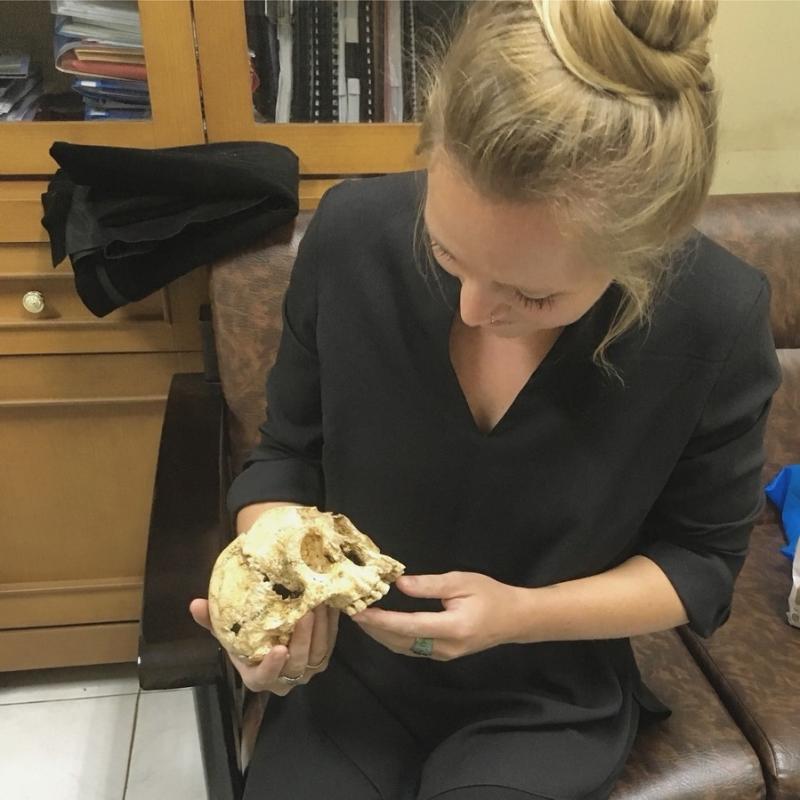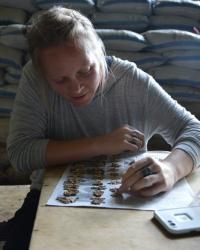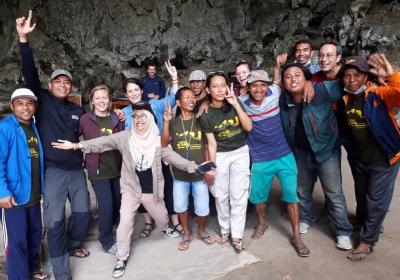For the Love of Fossils: An Interview with Paige Madison
“I’m Paige and I love fossils.”
That’s how Bio and Society alum Paige Madison introduces herself when she gives talks—something she’s been asked to do a lot lately.
Paige is a science writer and historian of paleoanthropology whose current research focuses on Homo floresiensis, an extinct species of small archaic human nicknamed the Hobbit. Scientists unearthed fossils of H. floresiensis in 2003, in a cave on the island of Flores, Indonesia. These big-footed, one-meter tall humans are believed to have inhabited Indonesia until the arrival of modern humans about 50,000 years ago.
Paige just signed a book contract to tell the story of the Hobbit’s discovery and how it shook up the paleoanthropology world. The book is called Strange Creatures Beyond Count and you can read more about why she chose that title here.
We spoke with Paige in February 2023 about her fascination with fossils and her academic path.
When did you first become interested in fossils?
As far back as I can recall. I was one of those kids who walked around with dinosaur toys and could pronounce Tyrannosaurus rex before I could pronounce very basic English terms. I was just absolutely obsessed. There are stories of me digging for dinosaurs in my Vermont backyard, which is hilarious because those were absolutely the wrong geological layers for finding fossils. Apparently I used to cry sometimes because I was afraid all the fossils had been found already, which is the most on-brand thing ever for me.
It's striking because I'm an identical twin and she had no interest in fossils. If you look at old pictures of us, she’s holding Barbie dolls and I’m holding dinosaurs. We used to go to the American Natural History Museum in New York City and apparently I was just completely amazed and loved the dinosaurs. My sister was interested more in the museum aspect. Still to this day she likes museums more than I do. She can walk around a museum and read labels for hours and I’d rather just sprint around and try to see what's next.
For college, I went to Montana State University, which is a great fossil school. I didn’t know it was a great fossil school at the time. I went there for skiing. [laughs] But at some point I knew I wanted to do anthropology. I was really interested in humans. I didn't yet know that there was such a thing as a fossil human. I remember the first time I flipped open a textbook and there was a hominin skull like that looked kind of apish and Other, but it also looked human. And I was hooked from that point.
When did you realize you didn’t want to be a practicing paleoanthropologist?
There were two moments that I remember feeling like I knew something was off—that I didn't want to be a paleoanthropologist, or that I hadn't yet found what I was interested in.
One was when I was taking an archeology class and I wrote a paper on Neanderthals. I was really excited about it and worked really hard on it. I remember I got an A-. And I had not put an A- amount of effort into that paper. So I was very confused. It took me a long time, years probably, to figure out that what had happened was I had written a history of science paper about how our conception of Neanderthals has changed over time. And that's very different from an archeology paper that says “Neanderthals used this stone tool technology, etc.”
The next moment was while studying dinosaur eggs in China as an undergraduate. We were measuring eggshell thickness. I was there with a few other 21-, 22-year-olds. I remember one girl was sitting next to me and the measurements she was making were consistently larger than mine. We were using the same tools, but we were using them slightly differently. I remember just being kind of devastated. Like these numbers were going to go into a textbook somewhere! It was a moment when I realized science wasn't totally objective.
Then I took a history of science class and we read a play that discusses some history of science concepts and there was a line about how measurement is not just a number, it's something done by a person in a specific context at a specific moment in time. And I remember reading that one line and suddenly all of the pieces fell into place.
Why did you choose ASU for graduate school?
It was starting to get time to apply to graduate school, and I wasn’t sure exactly what to do. I knew nothing about this discipline of the history of science. My history of science professor said, “I think you should look at ASU because they really like science-based historians and philosophers.” And I remember when he said that it was shocking to me because in paleoanthropology ASU is the number one program in the country. And so when he said ASU, I just laughed.
But I ended up applying. ASU is big in paleoanthropology in part because we have the Institute of Human Origins here. The director of the Institute at the time was Bill Kimbel, who sadly passed away last year. Bill was fantastic, and I really wanted to be in proximity with him. I remember I came down for recruitment week but I didn't have my full schedule yet. And so I sent an email to Bill and said “Hi, I'm Paige, I'd love to meet with you.” And he said, “Oh, funny, you're actually already on my calendar.” I was shocked, because somebody—probably Jane Maienschein—had already arranged the meeting. ASU was way ahead of me on this. [Editor’s note: Dr. Maienschein is University Professor, Regents’ Professor, and Director of the Center for Biology and Society at ASU.]
Jane and Bill ended up being my co-advisors and it really worked out great. They raised me to be this kind of greedy, interdisciplinary child with one foot in each discipline. Their argument was that my history was going to be better if I truly understood the science and also truly understood the direction it was going in. I remember sitting in on weekly journal club at the Institute of Human Origins and learning a ton about how to think about paleoanthropology because there were all these really incredible scientists and graduate students in a room just asking questions about this or that paper. And we did it every week.
It is those types of scholarly experiences that really ground my perspective and have shaped how I write about paleoanthropology—whether for history of science audiences, other paleoanthropologists, or popular science publications like National Geographic.
I really love fossils and I’m lucky to be able to share what I’ve learned about them with others.
Read more about Paige’s work here, and on her blog and follow her on Twitter @FossilHistory.


